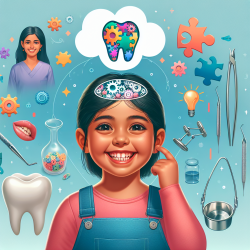Introduction
In the realm of pediatric therapy, understanding the genetic underpinnings of disorders is crucial for developing effective intervention strategies. The recent study titled "Partial Jacobsen syndrome phenotype in a patient with a de novo frameshift mutation in the ETS1 transcription factor" provides valuable insights into the genetic basis of Jacobsen syndrome and its associated clinical manifestations. This blog post aims to translate these findings into actionable strategies for practitioners working with children who have similar genetic profiles.
Understanding Jacobsen Syndrome and ETS1
Jacobsen syndrome is a rare chromosomal disorder caused by deletions in distal 11q, with a variable clinical phenotype that includes intellectual disability, behavioral problems, and congenital heart defects. The study highlights the role of the ETS1 gene, a transcription factor implicated in several of these clinical features, particularly congenital heart defects.
The research conducted by Tootleman et al. (2019) presents a comprehensive phenotypic analysis of a patient with a de novo frameshift mutation in ETS1, resulting in a "partial Jacobsen syndrome phenotype." This includes congenital heart disease, facial dysmorphism, intellectual disability, and attention deficit hyperactivity disorder (ADHD).
Implications for Practitioners
For speech-language pathologists and other pediatric therapists, these findings underscore the importance of a multidisciplinary approach to intervention. Here are some practical applications:
- Early Intervention: Recognize the importance of early intervention in children with genetic disorders. Early developmental milestones can be delayed, as seen in the study's patient, who required early intervention services for motor and speech delays.
- Comprehensive Assessment: Conduct thorough assessments that consider the potential for overlapping conditions such as ADHD and autism spectrum disorder, which are common in Jacobsen syndrome.
- Tailored Therapy Plans: Develop individualized therapy plans that address both cognitive and behavioral challenges. For example, integrating strategies to improve executive functioning and social skills can be beneficial.
- Collaboration with Medical Professionals: Collaborate with geneticists, cardiologists, and other specialists to ensure a holistic approach to the child's care. Understanding the medical aspects of the condition can inform therapy goals and strategies.
Encouraging Further Research
The study by Tootleman et al. opens the door for further research into the genetic mechanisms underlying Jacobsen syndrome and related disorders. Practitioners are encouraged to stay informed about emerging research and consider participating in or supporting studies that explore the genetic basis of developmental disorders.
Conclusion
By integrating the findings from genetic research into clinical practice, practitioners can enhance their ability to support children with complex genetic profiles. The insights gained from the study of ETS1 mutations in Jacobsen syndrome highlight the potential for targeted interventions that address both medical and developmental needs.
To read the original research paper, please follow this link: Partial Jacobsen syndrome phenotype in a patient with a de novo frameshift mutation in the ETS1 transcription factor.










